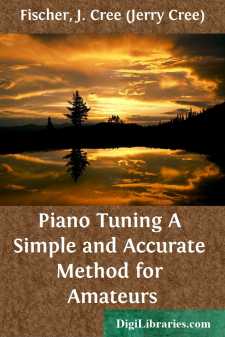Categories
- Antiques & Collectibles 13
- Architecture 36
- Art 48
- Bibles 22
- Biography & Autobiography 813
- Body, Mind & Spirit 142
- Business & Economics 28
- Children's Books 15
- Children's Fiction 12
- Computers 4
- Cooking 94
- Crafts & Hobbies 4
- Drama 346
- Education 46
- Family & Relationships 57
- Fiction 11828
- Games 19
- Gardening 17
- Health & Fitness 34
- History 1377
- House & Home 1
- Humor 147
- Juvenile Fiction 1873
- Juvenile Nonfiction 202
- Language Arts & Disciplines 88
- Law 16
- Literary Collections 686
- Literary Criticism 179
- Mathematics 13
- Medical 41
- Music 40
- Nature 179
- Non-Classifiable 1768
- Performing Arts 7
- Periodicals 1453
- Philosophy 64
- Photography 2
- Poetry 896
- Political Science 203
- Psychology 42
- Reference 154
- Religion 513
- Science 126
- Self-Help 84
- Social Science 81
- Sports & Recreation 34
- Study Aids 3
- Technology & Engineering 59
- Transportation 23
- Travel 463
- True Crime 29
Piano Tuning A Simple and Accurate Method for Amateurs
Categories:
Description:
Excerpt
INTRODUCTION.
Undoubtedly every human being is fitted for some sphere of usefulnesssome industry by which he can benefit mankind and support himself in comfort. Just what we are fitted for must, almost invariably, be decided by ourselves; and the sooner the better, else we may plod among the thousands whose lives are miserable failures for the reason that "they have missed their calling."
In the consideration of Piano Tuning as a profession, one should first determine if he possesses the necessary qualifications, the most important of which are a musical ear and some degree of mechanical ability. Having these, all else may be acquired by study. It is not necessary to possess a musical education or to be a musician; although a knowledge of music will be found a great aid. Still, an elementary knowledge of the principles of music is a necessity to the student of this course, as it has been found impossible to avoid the use of a few technical terms. In most cases, however, they are set forth in such a way that they will be readily apprehended by anyone who has even a slight knowledge of the fundamental principles of music.
In teaching Piano Tuning, it is the custom of the "Central School of Piano Tuning," for which these lessons were originally prepared, to have all students prepare two lessons in harmony as a test of their acquaintance with the intervals and chords used in tuning. The lessons are not difficult, and they embody only those principles which are essential to the proper understanding of the key-board: the intervals of the diatonic scale and the major common chord in the twelve different keys, C, D, E, F, G, A, B, B-flat, D-flat, E-flat, G-flat, and A-flat. In connection with the harmony lessons, we use as a text-book "Clarke's Harmony," and the student is required to master the first two chapters and prepare manuscripts upon each of the lessons. Below is a number of the most important questions selected from those lessons upon which manuscripts have been written:
1. Every white key on the piano represents an "absolute pitch." By what names are these pitches known? How are the black keys named?
2. How many tones constitute the diatonic scale? Give numerical names.
3. Intervals are measured by steps and half-steps. How many steps from 1 to 3 in the diatonic scale? 1 to 4? 1 to 5? 3 to 5? 5 to 8? 1 to 8?
4. Why is there no black key between E and F, and between B and C?
5. From 1 to 3 is called an interval of a third; from 3 to 5, also a third; from 1 to 5, a fifth: they are so called because they include, respectively, three and five members of the diatonic scale. What is the interval 3 to 6? 2 to 5? 5 to 8? 2 to 6? 1 to 8?
6. Thirds are of two kinds: major (larger) thirds embrace two whole-steps; minor (smaller) thirds embrace a step and a half. What kind of a third is 1-3 in the diatonic scale? 2-4? 3-5? 6-8?
7. What do we mean by the term, Fundamental of a chord? What is added to it to complete the common chord?
8. What absolute pitches comprise the common chord of C?...


